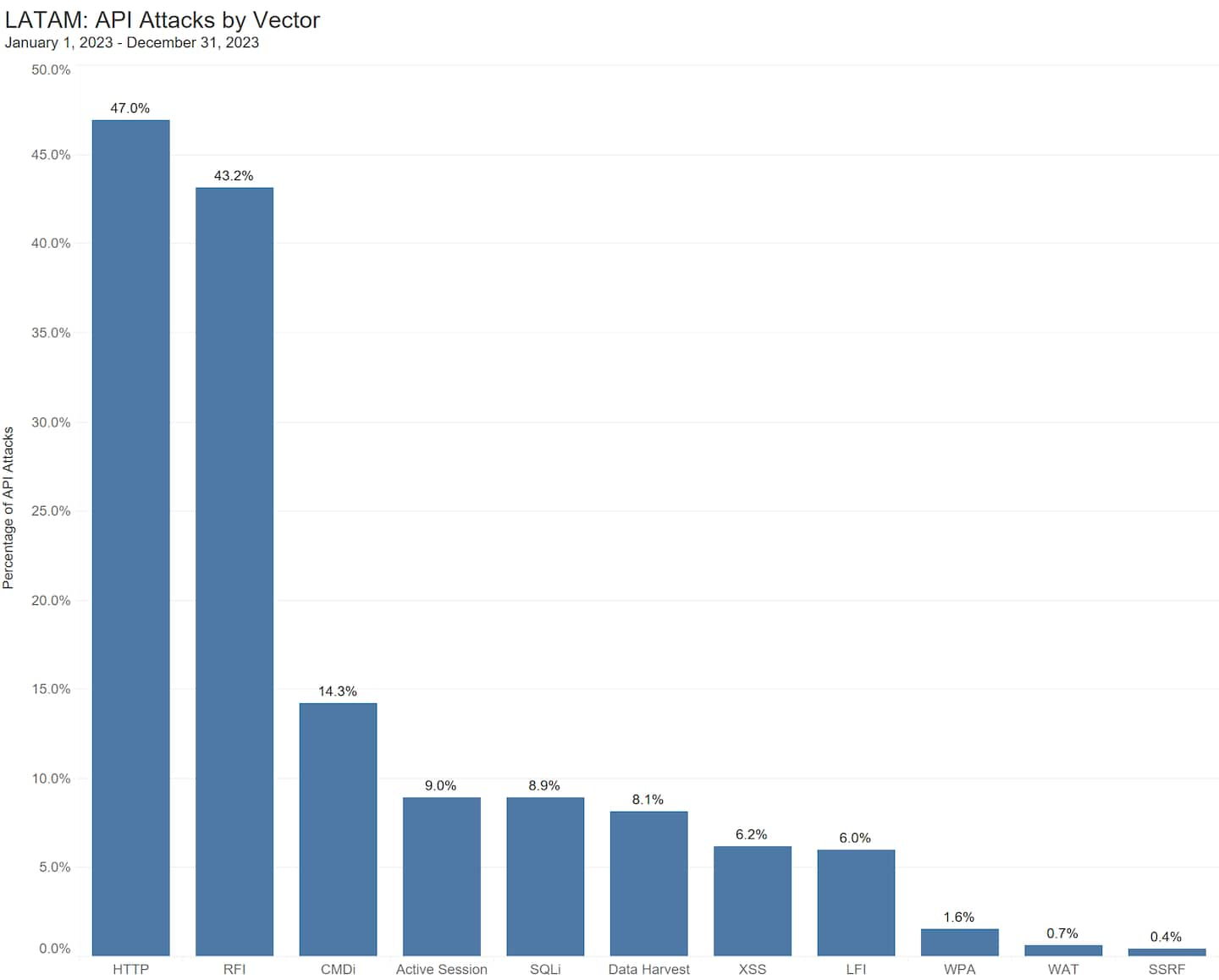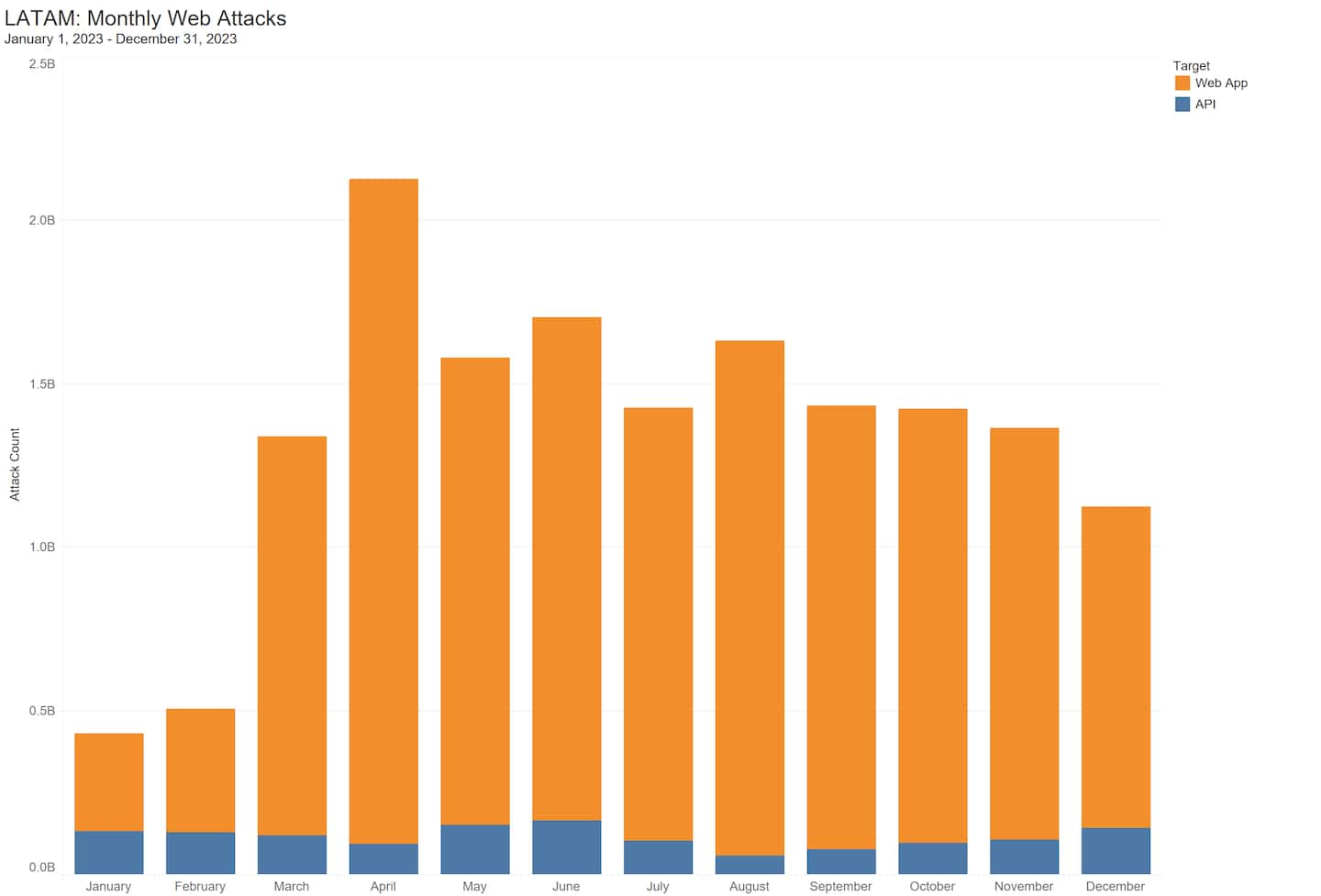API Cyberattacks: A Growing Threat for Organizations in Latin America
Executive summary
Hackers can exploit vulnerabilities in APIs to gain unauthorized access to sensitive data and disrupt services. The OWASP Top 10 API Security Risks 2023 report explores the most common risks associated with APIs.
Worldwide, industries such as banking, healthcare, energy, and ecommerce are particularly vulnerable to API cyberattacks as they rely heavily on interconnected systems to provide their services.
As more organizations in the Latin America (LATAM) region embrace the digital evolution and develop API-driven applications, the attack surface for API vulnerabilities has expanded.
Organizations can mitigate the risks associated with API vulnerabilities by implementing strong access controls and monitoring tools to detect suspicious activity.
It’s crucial for companies to prioritize cybersecurity measures and implement strong API security solutions to protect their systems and data from potential breaches.
Introduction
Application programming interfaces (APIs) have become essential components in modern software development, allowing different applications to communicate and interact with one another. However, with the increased use of APIs, cyberattacks targeting these interfaces have also increased.
The proliferation of APIs serves as a double-edged sword for organizations. While APIs streamline communication and foster innovation through third-party integration, they also expose businesses to a heightened risk of cyberthreats.
Cyberattacks targeting APIs have surged, exploiting vulnerabilities to compromise sensitive data and disrupt critical services. To fortify defenses, organizations must adopt stringent access controls and vigilant monitoring mechanisms to thwart malicious activities.
In this blog post, we'll delve into the pervasive threat of API cyberattacks and their profound impact on industries across LATAM. We'll also outline proactive strategies to fortify defenses against these evolving threats, empowering organizations to safeguard their digital assets and maintain operational resilience in an interconnected landscape.
How do API attacks affect organizations?
From financial losses to reputational damage, there are a number of ways that API cyberattacks can impact organizations, including:
Data breaches
Service disruption
Financial loss
Reputation damage
Data breaches
A common goal of web API attacks is to gain unauthorized access to sensitive data, including customer information, financial data, and intellectual property. Data breaches can result in legal repercussions, trust erosion, and financial penalties.
For example, a cyberattack on a financial institution could compromise customer account information, resulting in identity theft and financial fraud. This could not only damage the reputation of the institution but also lead to lawsuits and hefty fines imposed by regulatory authorities. Additionally, if intellectual property is stolen through a web API attack on a technology company, it could result in a loss of competitive advantage and revenue as competitors use the stolen information to develop similar products or services.
Service disruption
Cyberattacks on web APIs can lead to service downtime or disruptions, impacting business operations and customer satisfaction. Any disruption in services can have a detrimental impact on the industry. For instance, if a cyberattack targets a healthcare company's web API, it could lead to unauthorized access to patient data and compromise the patient’s privacy. This breach could result in lawsuits, fines, and damage to the company's reputation.
Financial loss
Web API attacks can also result in financial losses for any industry. These could be due to costs associated with remediation, legal fees, regulatory fines, and revenue loss. Companies across industries may struggle to recover from financial losses incurred as a result of cyberattacks.
Reputation damage
A business's reputation is crucial in any industry. A successful web API attack can lead to negative publicity and erode consumer trust. This can have long-term consequences for the business’s reputation and bottom line, impacting its ability to attract new customers and retain existing ones.
API threat analysis: key points to consider
In this precarious environment, failure to conduct thorough risk analyses can have severe repercussions, spanning financial losses and regulatory penalties to damaged brand reputation and customer trust. There are many points to consider during any API threat analysis. Here are just a few of them:
Increased attack surface: As more organizations expose their APIs to facilitate integration with third-party applications or services, the attack surface expands, providing cybercriminals with more entry points to launch attacks. This broader attack surface increases the likelihood of successful API cyberattacks.
Exploitation of vulnerabilities: Attackers target APIs to exploit vulnerabilities in the interfaces, such as inadequate authentication mechanisms, insecure data handling, or a lack of proper authorization controls. These vulnerabilities can be leveraged to gain unauthorized access to sensitive data or disrupt service operations.
Automated attacks: Attackers often use automated tools to scan for API vulnerabilities and launch attacks at scale. These automated attacks can overwhelm systems, leading to service downtime, data breaches, or other malicious activities. Failures in risk analysis can result in serious damage and significant consequences.
API cyberattacks in LATAM
API cyberattacks are a highly significant issue in LATAM, since these organizations play a vital role in the region's economic growth. As discussed earlier, API cyberattacks can disrupt business operations, leading to financial losses and negative impacts on the overall economy. Given this reality, organizations in LATAM must take proactive measures to protect themselves and prevent economic setbacks.
Countries in LATAM have experienced a rapid increase in digital evolution over the past decade, with organizations adopting new technologies and integrating their systems through APIs. This digital shift makes these organizations more susceptible to API cyberattacks. Understanding the issue is crucial to ensuring a secure digital evolution and protecting valuable data and services.
Countries in this region have also implemented strict data protection and cybersecurity regulations. Failing to address API cyberattacks could result in noncompliance with these regulations, leading to legal consequences and financial penalties. Understanding the issue helps ensure compliance with the region’s relevant laws and regulations.
Organizations in LATAM handle vast amounts of customer data, including personally identifiable information. API cyberattacks can compromise this sensitive data, leading to identity theft, fraud, and breaches of privacy. Organizations must safeguard consumer data, protect individuals, and maintain their trust. Failure to implement proper security measures can result in devastating consequences.
As previously mentioned, an organization's reputation is very important for the continuity of its business. This is particularly critical for organizations in many different industries in LATAM, as significant impacts can create space for competitors to gain a foothold with their clients and can allow foreign organizations the opportunity to expand their presence in a constantly evolving market.
Understanding the significance of API cyberattacks in LATAM is essential for protecting economies, complying with regulations, safeguarding consumer data, and preserving industry reputation. By recognizing the impact of API attacks, organizations in LATAM can address vulnerabilities and enhance their overall cybersecurity posture.
How are API attacks evolving in LATAM?
In 2023, API attacks continued to evolve, becoming more sophisticated and targeted. The reasons why API attacks remain a threat are multifaceted and include the growing use of APIs in various industries. As more organizations in LATAM embrace digital evolution and develop API-driven applications, the attack surface for API vulnerabilities continually expands.
Ransomware attacks targeting organizations' APIs to encrypt or steal sensitive data became more prevalent in 2023, posing a significant threat to businesses across various sectors in LATAM. Attackers have also increasingly targeted third-party APIs and supply chain dependencies to compromise multiple organizations. Integrations with business partner systems to improve processes and gain productivity through API data exchange opened a range of new attack opportunities, as well.
Because of the sensitive nature of financial data and transactions, the financial services sector in the LATAM region — including banking, insurance companies, payments, fintech, and cryptocurrency exchanges — has been a particular target of API attacks.
Compliance with data protection regulations such as the General Data Protection Regulation (GDPR) and the Lei Geral de Proteção de Dados Pessoais (LGPD) in Brazil has driven organizations in the LATAM region to enhance API security measures to protect personal and sensitive data from unauthorized access or disclosure.
In early 2023, the LATAM region had experienced close to 500,000 web application and API attacks (Figure 1). By the end of the year, that number had ballooned to 1.5 billion attacks. Figure 1 also shows the distribution between attacks directed at web applications and attacks directed at APIs. This trend indicates the importance of implementing strong security measures to protect APIs from malicious attacks.
Which industries in LATAM are vulnerable to API attacks?
When analyzing the industries impacted by API attacks, we see that the attackers don't have a clear preference. Rather, they seem to choose targets based on the possibility of financial gain and the sensitivity of the desired information, which can impact an organization's willingness to accept extortion.
Timing plays a factor, too. For example, an industry that’s currently booming because of some market characteristic or societal interest may be a more attractive target.
Financial services, commerce, healthcare, and government organizations are some of the most common sectors in LATAM that experience API attacks. These organizations typically handle large amounts of sensitive data and financial transactions, making them prime targets for cybercriminals.
While financial gain is certainly a motivator for cybercriminals, other factors, such as the value of the data being handled and the potential impact of an attack, also play a significant role in determining target industries. Additionally, industries with critical infrastructure or sensitive information may be targeted for malicious reasons beyond financial gain.
Financial services
The financial services industry experienced the highest percentage of API attacks in 2023, with 31.6% of the web attacks it received targeting APIs (Figure 2).
 Fig. 2: Financial services had the highest percentage of API attacks, partially due to the industry’s digital transformation and the nature of the sensitive information it holds
Fig. 2: Financial services had the highest percentage of API attacks, partially due to the industry’s digital transformation and the nature of the sensitive information it holds
This may not come as a surprise, considering the industry’s continuous growth and rapid pace of digital evolution. Financial services organizations are constantly introducing new applications, integrations, and facilities for customers — so the industry inevitably attracts a lot of attention.
However, there may be other motives for cyberattackers besides just money. For example, they may want to access sensitive customer information or disrupt critical infrastructure, both of which can have devastating business impacts.
Public sector
In 2023, the public sector was also a big API attack target because of its critical role in society and the possibility of high-profile impacts.
For example, government agencies hold vast amounts of sensitive information that could be valuable to cybercriminals, and disrupting government operations can have serious consequences for the entire population, making it an attractive target for those looking to cause chaos.
Commerce
The commerce industry is also a prime target for cyberattacks because of the vast amount of personal and financial data that’s exchanged online. The commerce industry relies heavily on technology for conducting transactions and storing customer information, making it vulnerable to cyberthreats. Cybercriminals often target online retailers and payment processors to steal confidential data or disrupt business operations.
The potential financial gain from hacking into these systems is a major incentive for cyberattackers, making the commerce industry a lucrative target for malicious actors. As technology continues to advance, cybersecurity will play an even more crucial role in protecting businesses and consumers alike.
Healthcare
Another factor that determines an attacker’s choice of target is the level of sensitivity of the information that can be captured. Some industries are potential targets because of the criticality of the information they hold.
The healthcare industry, for example, holds not only personal and financial data but also sensitive medical records, making it a prime target for cyberattacks. Another important aspect is that these organizations are often more willing to accept ransom demands to prevent the release of sensitive information.
Attackers often conduct thorough research to identify which industries hold the most valuable information. By targeting organizations with critical information, they can maximize their potential financial gain or service impact and increase the likelihood of their demands being met.
Common attack vectors in LATAM
As industries in LATAM embrace digital evolution and leverage APIs to enable seamless integration and innovation, the threat of API attacks looms large. Cybercriminals are constantly evolving their tactics to exploit vulnerabilities in APIs, posing significant risks to industries.
Let’s take a look at some common API attack vectors encountered in LATAM and explore strategies to mitigate these threats (Figure 3).
 Fig. 3: HTTP, RFI, and CMDi are the top three vectors in API attacks in the LATAM region
Fig. 3: HTTP, RFI, and CMDi are the top three vectors in API attacks in the LATAM region
HTTP attacks
HTTP attacks top of the list in LATAM, with 47.0% of these attacks targeting APIs. HTTP attacks involve exploiting vulnerabilities in web APIs that use the HTTP protocol. These attacks can have various goals, including stealing sensitive data, gaining unauthorized access, disrupting services, or executing malicious code on the server.
Remote file inclusion attacks
Remote file inclusion (RFI) attacks, which typically target web applications that use dynamic file inclusion mechanisms like include(), require(), or comparable functions in server-side scripting languages like PHP, come in second in the region with 43.2% of these attacks targeting APIs.
Command injection attacks
The third most common attack vector is command injection (CMDi) attacks, at 14% of these attacks targeting APIs. These attacks are often used to execute arbitrary commands on a vulnerable server or system, where the attacker can gain unauthorized access to execute system commands on the underlying system as part of their functionality. They can be used to execute shell commands, upload and process files, execute a search or database query, and much more.
It’s important to note that other types of attacks, such as API abuse, authentication attacks, denial-of-service (DoS), Structured Query Language injection (SQLi), cross-site scripting (XSS), and local file inclusion (LFI), also pose significant threats to APIs and should not be overlooked.
Implementing comprehensive security measures can help mitigate the risk of all types of API attacks. With the increasing reliance on applications, it’s crucial to prioritize security measures to protect against various types of attacks.
Akamai's comprehensive app and API solution family offers a range of security features, like full visibility of all APIs (vertical and horizontal), visibility of shadow and rogue APIs, historical behavior analysis, API vulnerability analysis, and more.
Conclusion
APIs play a pivotal role in driving digital innovation and integration in industries in LATAM. However, the growing prevalence of API attack vectors poses a significant risk to the region's digital ecosystems, data privacy, and overall security.
By understanding and proactively addressing these common API attack vectors, organizations in LATAM can bolster their cybersecurity defenses, safeguard customer data, and uphold the trust of stakeholders.
Best practices to help protect APIs
By following these best practices for safe API use, organizations in LATAM can help build a prosperous digital future for industries across the region.
Document all APIs in your API security controls for enhanced visibility
Address misconfiguration issues in your APIs and implement processes to prevent future vulnerabilities from emerging
Establish an API monitoring and threat hunting discipline to close security gaps before attackers can use them against you
Choose a security solution that can mitigate a whole range of threats, from the OWASP Top 10 API Security Risks to traditional web attacks
Use security solutions that offer behavioral analytics to detect business logic abuse and other anomalies
Leverage the OWASP guidance on coding practices to prevent the most common attacks
Conduct regular vulnerability assessments and select a world-class security solution provider to support you
Stay abreast of emerging threats





